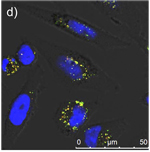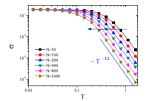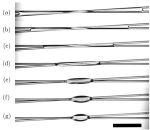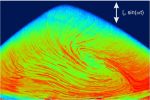News
EPJ Quantum Technology Highlight - Gold-diamond nanodevice for hyperlocalised cancer therapy
- Details
- Published on 29 July 2015

Gold nanorods can be used as remote controlled nanoheaters delivering the right amount of thermal treatment to cancer cells, thanks to diamond nanocrystals used as temperature sensors
Precise targeting biological molecules, such as cancer cells, for treatment is a challenge, due to their sheer size. Now ,Taiwanese scientists have proposed an advanced solution, based on a novel combination of previously used techniques, which can potentially be applied to thermal cancer therapy. Pei-Chang Tsai from the Institute of Atomic and Molecular Sciences, at the Academia Sinica, Taipei, and colleagues just published in EPJ QT an improved sensing technique for nanometre-scale heating and temperature sensing. Using a chemical method to attach gold nanorods to the surface of a diamond nanocrystal, the authors have invented a new biocompatible nanodevice. It is capable of delivering extremely localised heating from a near-infrared laser aimed at the gold nanorods, while accurately sensing temperature with the nanocrystals.
EPJ D Highlight - Identifying ever-growing disturbances leading to freak waves
- Details
- Published on 27 July 2015

Physicists now better understand wave systems exhibiting unusual disturbances by identifying growing localised patterns as early indicators of such disturbances
Physicists like to study unusual kinds of waves, like freak waves found in the sea. Such wave movements can be studied using models designed to describe the dynamics of disturbances. Theoretical physicists, based in France have focused on finding ways of best explaining how wave disturbance occurs under very specific initial conditions that are key to the genesis of these disturbances. They looked for solutions to this puzzle by resolving a type of equation, called the nonlinear Schrödinger equation. It is solved by applying a method designed for studying instabilities tailored to these initial conditions. Their approach makes it possible to locate exactly where and how pertinent information used to identify disturbance patterns can be extracted from localised disturbances' characteristics. The findings have been published in EPJ D by Saliya Coulibaly, from the University of Lille, and colleagues.
EPJ D Colloquium - How many orthonormal bases are needed to distinguish all pure quantum states?
- Details
- Published on 22 July 2015
How many different measurement settings are needed in order to uniquely determine a pure quantum state, and how should such measurements be chosen? This problem goes back to a famous remark by Wolfgang Pauli in 1933, in which he raised the question whether or not the position and the momentum distributions are enough to define the wave function uniquely modulo a global phase. The original Pauli problem has a negative answer, but it has evolved into many interesting variants and has been studied from several fruitful perspectives.
In this review article the authors concentrate on a specific form of the Pauli problem, which is concerned with the minimal number of orthonormal bases in a finite dimensional Hilbert space that is needed in order to distinguish all pure quantum states.
EPJ B Highlight - Law governing anomalous heat conduction revealed
- Details
- Published on 07 July 2015

Study finds the law governing how heat transport scales up with temperature
How heat travels, matters. Yet, there is still no consensus on the exact physical mechanism that causes anomalous heat conduction - despite the existence of previous numerical simulation, theoretical predictions and experimental observations. Now, a team based in Asia has demonstrated that electron transport depends on temperature. It follows a scaling governed by a power law - and not the exponential scaling previously envisaged. These findings were recently published in EPJ B by Yunyun Li Tongji University, Shanghai, China, and colleagues in Singapore.
EPJ Plus Highlight - Does that “green” plasticiser make my PVC flexible enough for you?
- Details
- Published on 03 July 2015

A study of an eco-friendly solvent helping to make PVC plastic more flexible reveals the molecular-level interaction of hydrogen bonds between the two ingredients
What gives plastic objects their flexibility and reduces their brittleness is the concentration of plasticiser. For example, a chemical solvent of the phthalate family called DOP is often used. The trouble is there are concerns that phthalates present health risks. So there is a demand for more alternatives. Now, scientists from China have examined the effect of using DEHHP, a new eco-friendly plasticiser, used in combination with PVC. For a plasticiser to work, there has to be adequate hydrogen bonding with the plastic. By combining experiments and simulations, the team revealed why the polymer-solvent hydrogen bonding interaction's strength decreases with dilution at a molecular level—which is a phenomenon also observed in the DOP-PVC combination. These findings have been published in EPJ Plus by Yang Liu from Nanjing University and colleagues.
EPJ TI Review - Tip-enhanced Raman spectroscopy
- Details
- Published on 03 July 2015

As part of the Thematic Series on Raman Spectroscopies, a new Review Article has just been published providing a detailed overview of the state-of-the-art in Tip-Enhanced Raman Spectroscopy (TERS). The authors discuss the capabilities of TERS, demonstrated through a summary of the major achievements of TERS techniques across many different fields of scientific research. It focuses on ongoing and potential applications of TERS including those in materials science, chemical science and biological science. Finally, the authors present an outlook on future development of the technique and the mechanisms being investigated to help achieve high signal enhancement and spatial resolution.
EPJ TI - Review of multidimensional data processing approaches for Raman and infrared spectroscopy
- Details
- Published on 03 July 2015

A recent Review Article in EPJ Techniques and Instrumentation provides an overview of the latest data processing and pre-processing methods commonly used in Raman and IR spectroscopy, including imaging for better qualitative and quantitative analysis of biological samples.
Raman and Infrared (IR) spectroscopies provide information about the structure, functional groups and environment of the molecules in a sample. Over the past few decades Raman and IR microspectroscopy based techniques have been extensively used to understand fundamental biology and responses of living systems under diverse physiological and pathological conditions. The spectra from biological systems are complex and diverse, owing to their heterogeneous nature consisting of bio-molecules such as proteins, lipids, nucleic acids, carbohydrates etc. Therefore, interpretation of the results obtained is difficult and to overcome this various data mining methods are employed. These methods must be suitable for handling large multidimensional data sets and for exploring the complete spectral information simultaneously.
EPJ B Highlight - Structural shift elucidated with large-scale atomic simulations
- Details
- Published on 30 June 2015

Iron-Nickel alloys’ structure changes as they heat up and cool down
Iron-nickel alloys are ubiquitous: they are found at the earth’s core and in meteorites. What is fascinating about such alloys is that their inner structure can change with rapid temperature swings. Heated up above 730 °C (1,340 °F), these alloys enter what is referred to as an austenitic phase. Alternatively, they can be turned into very hard alloys, referred to as a martensitic phase, by subjecting them to extremely rapid cooling. Now a team of scientists from Germany has, for the first time, created a large-scale simulation involving 275,000 atoms representing iron-nickel alloys in proportions found in nature. They show that transitions from one alloy structure to the other occurs in both an orderly and a disorderly way, depending on whether it is heated up or cooled down, respectively. These findings have been published in EPJ B by Emilia Sak-Saracino and Herbert Urbassek from the Research Center OPTIMAS at the University of Kaiserslautern, in Germany.
EPJ E Highlight - Improving insulation materials, down to wetting crossed fibres
- Details
- Published on 30 June 2015

Scientists model the manner in which a liquid wets fibres, gaining useful insights for improving glass wool properties
Sandcastles are a prime example of how adding a small amount of liquid to a granular material changes its characteristics. But understanding the effect of a liquid wetting randomly oriented fibres in a fibrous medium remains a mystery. Relevant to the building industry, which uses glass wool, for instance, this phenomenon can be better understood by studying the behaviour of a liquid trapped between two parallel fibres. It can either remain in the shape of a drop or spread between the fibres into a long and thin column of liquid. Now, scientists have demonstrated that the spreading of the liquid is controlled by three key parameters: the amount of liquid on the fibres, the fibres’ orientation and the minimum distance between them. These findings, based on experimental and modelling work, were recently published in EPJ E. The authors are Alban Sauret, a scientist working at a laboratory jointly operated by the CNRS and Saint-Gobain, a building materials manufacturer in France, and international colleagues based at Princeton University and the NYU School of Engineering, USA.
EPJ E Colloquium - The role of acoustic streaming in vertically vibrated granular beds
- Details
- Published on 30 June 2015

A recent EPJ E Colloquium by Jose Manuel Valverde looks at the fundamental physics that causes convection and fluidization in vibrated beds of particles with large inertia. The author examines the question of whether acoustic streaming arising from oscillatory viscous flows might play a role on the onset of convection and fluidization in vertically vibrated granular beds.
Acoustic streaming, first observed by Faraday in 1831, is an enigmatic phenomenon that has puzzled physicists for a long time. It occurs when a viscous fluid oscillates in the presence of a solid boundary. The dissipation of energy by viscous friction leads to a secondary steady circulation of fluid in a boundary layer near the surface of the solid, which enhances the gas-solid viscous interaction. Granular beds display, at sufficiently high vibrational intensities, surface patterns that bear a stunning resemblance to the surface ripples (Faraday waves) observed for low viscosity liquids. This suggests that the granular bed transits to a liquid-like regime, despite the large inertia of the particles.




